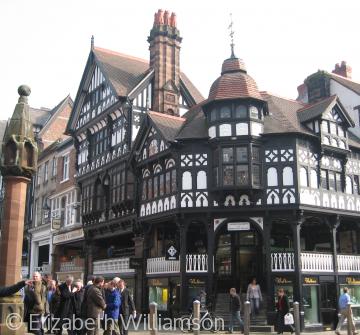Urban Buildings
 Chester, The Rows, medieval houses and shops restored in 1888 by the architect T.M. Lockwood.
Chester, The Rows, medieval houses and shops restored in 1888 by the architect T.M. Lockwood.The great variety of public, private and commercial activities pursued in towns and cities can be traced in their buildings. Until the 20th century when planning regulations decreed that industrial, commercial and residential areas should be separated, most people lived in close proximity to their work. In medieval towns, such as Burford and Henley, shops and warehouses were incorporated in houses, though in many towns where trade was crucial to the economy separate granaries and warehouses were established as well. Workshops and manufactories filled the plots behind dwellings, and in Cornwall fish processing was carried out below living accommodation; indeed many people - including business proprietors - lived surprisingly close to noxious industries such as tanning.
From the late 17th century, exclusively residential suburbs grew up on the peripheries of commercial centres, especially in large towns such as Sunderland. Suburban development often followed a pattern used widely in London: landowners laid out streets and leased plots to speculators who built the houses and leased them to professionals and merchants who wanted to live at some distance from their business. The most affluent built themselves detached houses on large plots. Some continued to live on their business premises, as did the 18th-century tanner who built a large detached house next to his works in Newent, Gloucestershire. The development of such residential areas brought the need for new churches, and in the most populous areas, for example London’s Westminster, new parishes. The urban poor lived either in cottages which had survived from a less dense and urban way of life, in old houses subdivided into tenements, or in narrow courts of poorly built cottages thrown up by speculators on land behind and between other properties.
Industrialisation enforced a different living and working pattern. Factories and mills were sited close to sources of waterpower and transport, often on edges on towns. Few employers provided new well-designed dwellings for their workers who continued to live in old courts and cottages or rented terraced houses newly – and densely - laid out by speculative builders. By the mid-19th century many middle-class shopkeepers, clerks and artisans preferred to live away from their shops and workshops in villas and terraces built for rent or purchase. Their houses were larger (sometimes with space for servants), on more spacious plots which included gardens, and were made socially distinct by fashionable mass-produced decoration. The new suburbs were provided with churches, schools, and cultural buildings, often built on sites allocated by the developer of the neighbourhood or by philanthropists who bought them especially for the purpose. Developers sometimes focussed the suburb on a public park with the aim of attracting a high-class of resident. Such developments might be laid out with different classes of dwelling, the smartest nearest the park or on the widest road, with houses for tradesmen and servants in adjoining streets.
As people moved away from them, town centres changed. Most became dominated by commercial and local government functions. Large covered markets, sometimes part of other public or commercial buildings, were imposed on old market places and competed in prominence with public buildings such as town halls and libraries, theatres and corn exchanges. Covered shopping arcades, including the Royal Arcade Norwich, linked streets and invited shoppers in with eye-catching fronts. Distinctive house styles were introduced by banks and, with the rise of chain of shops such as W.H. Smith and Montagu Burton, they began to dominate town and city centres in the 20th century. The flight of residents increased. The smartest Georgian houses were colonised by solicitors and other professional firms, while living accommodation over shops became store rooms or vacant. In Sunderland and Newlyn in Cornwall and other industrial towns and ports, whole neighbourhoods were degraded by the arrival of industry. The remaining old houses and often degenerated into slums and were eventually cleared. In many towns huge enclosed shopping centres obliterated street patterns and what survived of a close-knit texture of workplace and home.










